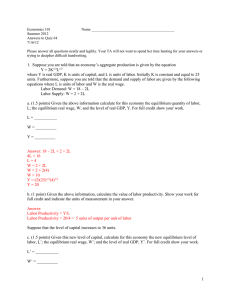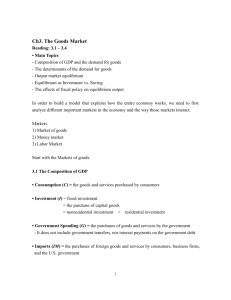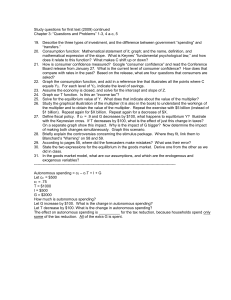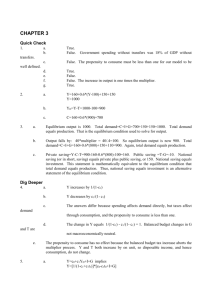Chap. 3 - The Goods Market
advertisement
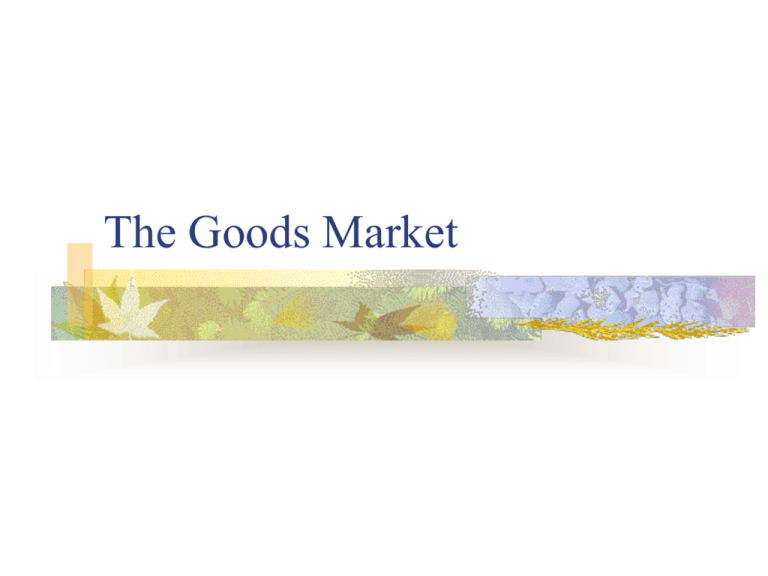
The Goods Market The Composition of GDP Consumption (C) refers to the goods and services purchased by consumers. Investment (I), sometimes called fixed investment, is the purchase of capital goods. It is the sum of nonresidential investment and residential investment. The Composition of GDP Government Spending (G) refers to the purchases of goods and services by the federal, state, and local governments. It does not include government transfers, nor interest payments on the government debt. Imports (IM) are the purchases of foreign goods and services by consumers, business firms, and the U.S. government. Exports (X) are the purchases of U.S. goods and services by foreigners. The Composition of GDP Net exports (X IM) is the difference between exports and imports, also called the trade balance. Inventory investment is the difference between production and sales. The Model - Assumptions Variables that depend on other variables within the model are called endogenous. Variables that are not explain within the model are called exogenous. The Demand for Goods Identity The total demand for goods is written as: Z C I G X IM Under the assumption that the economy is closed, X = IM = 0, then: Z C I G Consumption C C(YD ) ( ) The function C(YD) is called the consumption function. It is a behavioral function, that is, it captures the behavior of consumers. Disposable income, (YD) YD Y T Consumption (C) A more specific form of the consumption function is this linear relation: C c0 c1YD This function has two parameters: c1 - propensity to consume c0 - intercept of the consumption function Consumption (C) Consumption increases with disposable income, but less than one for one. C C(YD ) YD Y T C c0 c1 (Y T ) Investment (I) Investment here is taken as given (an exogenous variable): I I Government Spending (G) Government spending, G, together with taxes, T, describes fiscal policy. We shall assume that G and T are also exogenous. The Determination of Equilibrium Output Equilibrium in the goods market requires that production, Y, be equal to the demand for goods, Z: Y Z Then: Y c0 c1 (Y T ) I G Using Algebra Y c0 c1 (Y T ) I G How many endogenous variables? How many equations? Can we solve this? 1 Y [c0 I G c1T ] 1 c1 multiplier autonomous spending Using a GraphZ (c Equilibrium in the Goods Market Equilibrium output is determined by the condition that production be equal to demand. 0 I G c1T ) c1Y Using a Graph The Effects of an Increase in Autonomous An increase in Spendingspending on Output autonomous has a more than onefor-one effect on equilibrium output. John Maynard Keynes, 1883-1946 The General Theory of Employment, Interest and Money (1936). “The Objective of International Price Stability” (EJ, 1943) The Keynesian Multiplier An increase in demand leads to an increase in production and a corresponding increase in income. The end result is an increase in output that is larger than the initial shift in demand, by a factor equal to the multiplier. Using a Graph The Effects of an Increase in Autonomous An increase in Spendingspending on Output autonomous has a more than onefor-one effect on equilibrium output. How Long Does It Take for Output to Adjust? The speed of adjustment depends on how and how often firms revise their production schedule. Describing formally the adjustment of output over time is what economists call the dynamics of adjustment. An Alternative Way of Thinking about GoodsMarket Equilibrium Saving is the sum of private plus public saving. Private saving (S), is saving by consumers. Public saving equals taxes minus government spending. S YTC Y C I G Y T C I G T S I G T I S ( T G) Investment Equals Saving I S ( T G) Investment equals saving—the sum of private plus public saving. This equilibrium condition for the goods market is called the IS relation: what firms want to invest must be equal to what people and the government want to save. Savings = Investment Consumption and saving decisions are one and the same. S YTC S Y T c0 c1 (T T ) S c0 (1 c1 )(Y T ) In equilibrium: I c0 (1 c1 )(Y T ) (T G) Rearranging terms, we get the same result as before: 1 Y [c0 I G c1T ] 1 c1 Saving and Investment around the World
